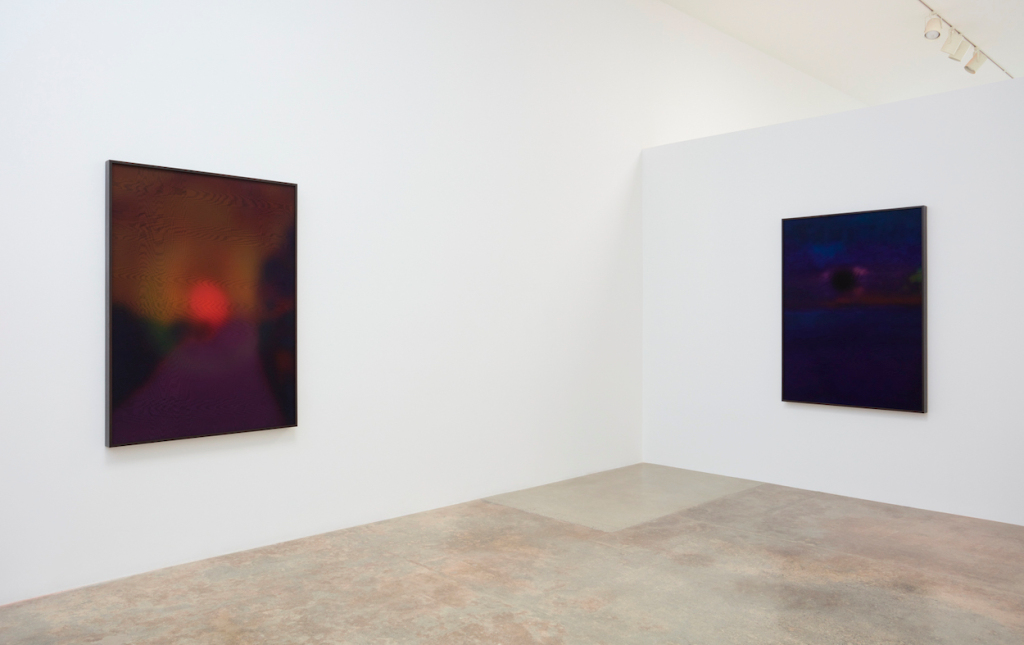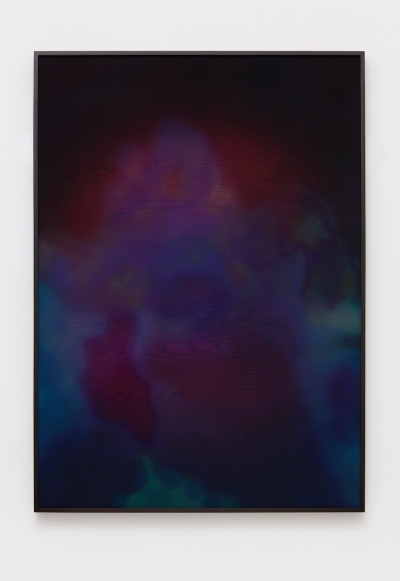 View of “Afterimages,” 2021, at Kayne Griffin, Los Angeles, showing Afterimage, Red Eye, 2021, and Afterimage, Night Vision, 2021. Courtesy the artist and Kayne Griffin, Los Angeles. Photo: Flying Studio.
View of “Afterimages,” 2021, at Kayne Griffin, Los Angeles, showing Afterimage, Red Eye, 2021, and Afterimage, Night Vision, 2021. Courtesy the artist and Kayne Griffin, Los Angeles. Photo: Flying Studio.
A fireball pops from a dark background suffused with a dismal yellow glow. Below the red-orange orb, vague bluish masses border a deep-violet promontory. As one approaches this image, wavy patterns shimmer like mirages, confounding the eyes and interrupting the visual experience induced by Rosha Yaghmai’s painting, Afterimage, Red Eye, rendered in acrylic and ink on organza and cotton.
Yaghmai created each of the seven wall-hung pieces in “Afterimages” (all works 2021) at Kayne Griffin in Los Angeles by airbrushing multiple pieces of translucent organza and then layering them within a frame to create moiré patterns that appear to vibrate and shift as one walks by them. She devised the compositions by digitally enlarging, editing, and abstracting elements of Persian miniatures similar to those once displayed in her childhood home. Alluding to her own dissociation from a culture that she never fully knew as a native-born Californian of Iranian heritage, the artist positions her reimagined scenes as “afterimages” of those remembered pictures. Her blurry color fields and indiscernible shapes seem, paradoxically, both effulgent and shadowy, evoking the kaleidoscopic impressions that linger on one’s retina after gazing at the sun. They linger on the verge of coalescing into something representational. In Afterimage, Night Vision, a fuzzy dark dot—a blind spot, perhaps, or an ocular floater—hovers portentously in what appear to be twilit clouds over a blue ocean.
Persian miniatures, which illustrate scenes from poetry, religious texts, and histories, are often endowed with mythical qualities. Yaghmai’s hallucinogenic permutations imbue such depictions with fresh layers of fantasy. It’s difficult to extrapolate her source images from what’s on view; instead, her pictures seem to have taken on entirely new yet mysterious meanings. Their suggestions of indistinct figures and obscure landscape features hint at fragmented narratives impossible to piece together. For example, the bright shape in the upper right corner of Afterimage, Floating could be read as a fiery mask gazing upward, but no other pictorial cues support such an interpretation.
The luminous minimalism of these new paintings and their tenuous relationship to representation further Yaghmai’s affinity with Light and Space artists of the 1960s and ’70s, including Larry Bell and Mary Corse, who emphasized optical and material effects in experiential works inspired by aspects of their Los Angeles environs. But this show also distinguishes the younger artist’s response. Whereas her predecessors favored rigid materials associated with car culture, such as glass, resin, and plastic, Yaghmai’s pliable fabrics could be interpreted as a nod to Iran’s rich textile traditions. And in a manner redolent of Bell’s nested and hazily colored glass cubes, her works filter light through several layers, but unlike his reflective medium, her diaphanous organza absorbs some light, as does a scarf or veil, partially concealing what is behind it.
 Rosha Yaghmai, Afterimage, Blue Mountain, 2021, acrylic and ink on organza and cotton, 60 by 43 by 2 ¾ inches. Courtesy the artist and Kayne Griffin, Los Angeles. Photo: Flying Studio, Los Angeles. © Rosha Yaghmai
Rosha Yaghmai, Afterimage, Blue Mountain, 2021, acrylic and ink on organza and cotton, 60 by 43 by 2 ¾ inches. Courtesy the artist and Kayne Griffin, Los Angeles. Photo: Flying Studio, Los Angeles. © Rosha Yaghmai
Indeed, if Light and Space artists’ concerns were primarily formal, often simulating movement, suspension, or dislocation, and prompted by California’s stereotypical association with sun and freeways, Yaghmai’s incorporation of oblique autobiographical references gestures toward the estrangement effect of time and migration on a person’s sense of place and identity, perhaps nodding to the state’s other associations with transplants and diasporic communities. The artist’s relation to space unfolds through dual references to Los Angeles and Iran: several of her works refer to mountains while others recall wildfires, the sea, streetlights, and the boteh motif common in Persian textiles.
These paintings diverge from the sculptural practice for which Yaghmai is known; but she has, in fact, employed identical source imagery in previous bodies of work, including an installation for “Made in L.A. 2018,” which featured Slide Samples (Lures, Myths), 2018, a window-like screen with articulated panels on which she projected slides her father had taken in 1969, soon after immigrating to the United States from Tehran. The periodically changing photos and refracted light generated an eerie, nostalgic sense of evanescence. Hanging on a nearby wall was Silicone (Book of Kings, p. 69), 2018, which rendered in mixed media a blurry landscape based on one of the same Persian miniatures that she has reinterpreted here. As with those earlier pieces, the distortions and optical effects in “Afterimages” speak to the slipperiness of myths and visions across cultures and time. Yet her methods and forms are here pared back to their essence. Instead of relying on extrinsic light sources and direct representation, she has honed her pieces’ self-contained perceptual impact; their contrasting vivid hues, absorbing scale, and simple, evocative compositions leave the viewer with more succinct impressions. Long after one sees these paintings, their ghostly images continue to haunt the mind’s eye.
Source link : https://www.artnews.com/art-in-america/aia-reviews/rosha-yaghmai-afterimages-kayne-griffin-1234602152












